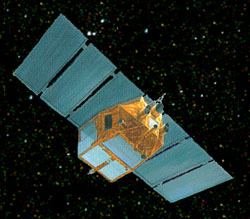cosmos.wikisort.org - Nave_espacial
BeppoSAX fue un observatorio espacial de rayos X fruto de la colaboración entre los Países Bajos e Italia. Originalmente denominado SAX (Satellite per Astronomia X, en italiano), fue renombrado BeppoSAX en honor a Giuseppe "Beppo" Occhialini, físico italiano. El observatorio fue lanzado el 30 de abril de 1996 mediante un cohete Atlas desde Cabo Cañaveral. Al final de su misión reentró en la atmósfera, el 29 de abril de 2003.
| BeppoSAX | ||
|---|---|---|
 Representación artística de BeppoSAX | ||
| Estado | Reentrado en la atmósfera | |
| Tipo de misión | Observatorio espacial | |
| Operador | Agencia Espacial Italiana | |
| ID COSPAR | 1996-027A | |
| no. SATCAT | 23857 | |
| ID NSSDCA | 1996-027A | |
| Duración de la misión | 9559 días y 22 horas | |
| Propiedades de la nave | ||
| Fabricante | Alenia Aeronautica | |
| Masa de lanzamiento | 900 kg | |
| Comienzo de la misión | ||
| Lanzamiento | 30 de abril de 1996 | |
| Vehículo | Atlas | |
| Lugar | Cabo Cañaveral | |
| Fin de la misión | ||
| Tipo | reingreso | |
| Fecha de decaída | Reingreso = 29 de abril de 2003 | |
| Parámetros orbitales | ||
| Excentricidad | 0.00136 | |
| Altitud del periastro | 575 kilómetros | |
| Altitud del apastro | 594 kilómetros | |
| Inclinación | 4 grados sexagesimales | |
| Período | 96.4 minutos | |
La misión de BeppoSAX fue realizar estudios espectroscópicos y de variabilidad temporal de fuentes celestes de rayos X en la banda de energías entre 1 y 200 keV, incluyendo una monitorización completa del cielo para la detección de eventos transitorios en el rango entre 2 a 30 keV.
Entre la instrumentación, el satélite portaba cuatro concentradores de rayos X sensibles a energías entre 1 y 10 keV (con uno de ellos capaz de detectar energías tan bajas como 0,1 keV), un centelleador de gas sensible a entre 3 y 12 keV y un centelleador de cristal de ioduro de sodio para energías entre 15 y 200 keV.
Referencias
- Wade, Mark (2008). «SAX» (en inglés). Archivado desde el original el 5 de enero de 2009. Consultado el 28 de abril de 2009.
- NASA (5 de agosto de 2008). «SAX» (en inglés). Consultado el 28 de abril de 2009.
Enlaces externos
На других языках
[de] BeppoSAX
BeppoSAX war ein italienisch/niederländischer Forschungssatellit für astronomische Beobachtungen mit Röntgenstrahlen.[en] BeppoSAX
BeppoSAX was an Italian–Dutch satellite for X-ray astronomy which played a crucial role in resolving the origin of gamma-ray bursts (GRBs), the most energetic events known in the universe. It was the first X-ray mission capable of simultaneously observing targets over more than 3 decades of energy, from 0.1 to 300 kiloelectronvolts (keV) with relatively large area, good (for the time) energy resolution and imaging capabilities (with a spatial resolution of 1 arc minute between 0.1 and 10 keV). BeppoSAX was a major programme of the Italian Space Agency (ASI) with the participation of the Netherlands Agency for Aerospace Programmes (NIVR). The prime contractor for the space segment was Alenia while Nuova Telespazio led the development of the ground segment. Most of the scientific instruments were developed by the Italian National Research Council (CNR) while the Wide Field Cameras were developed by the Netherlands Institute for Space Research (SRON) and the LECS was developed by the astrophysics division of the European Space Agency's ESTEC facility.- [es] BeppoSAX
[ru] BeppoSAX
BeppoSAX (итал. Satellite per Astronomia a raggi X) — итальянско-голландская орбитальная рентгеновская обсерватория. Спутник и научная аппаратура была произведена различными итальянскими и голландскими компаниями, основные научные инструменты — в Италии, широкоугольная камера (WFC) — в Нидерландах (SRON).Другой контент может иметь иную лицензию. Перед использованием материалов сайта WikiSort.org внимательно изучите правила лицензирования конкретных элементов наполнения сайта.
WikiSort.org - проект по пересортировке и дополнению контента Википедии